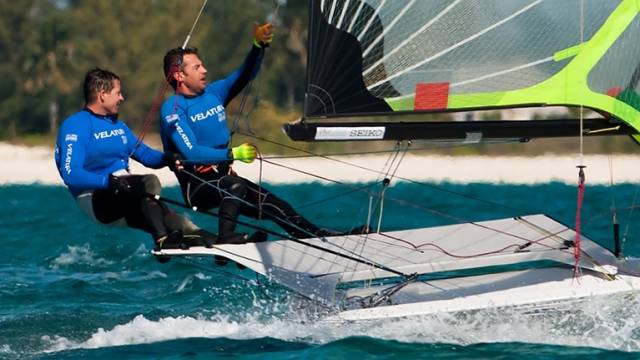Is it a bird, is it a plane? The International 49er Skiff is twenty years old in 2016, and it has been part of the Olympics since 2000. Yet for most sailors it is still as modern and bewildering as the day after tomorrow. W M Nixon tries to make sense of a class which finds itself in a good place in Ireland at the moment.
It doesn’t do to think too hard about the slim 16ft 49er skiff. Almost immediately you’ll jump to the conclusion that it’s actually a trimaran which is still awaiting the fitting of its floats. And then, when you see them zooming along at full speed with all three sails pulling in perfect unison and the crew of two exactly horizontal and cool as you please on their trapezes, you can’t help but think that it’s all too good to be true, for what they’re doing is equivalent to balancing – indeed ballet dancing - on the head of a pin, and the slightest error will lead to a sudden and almighty mess.
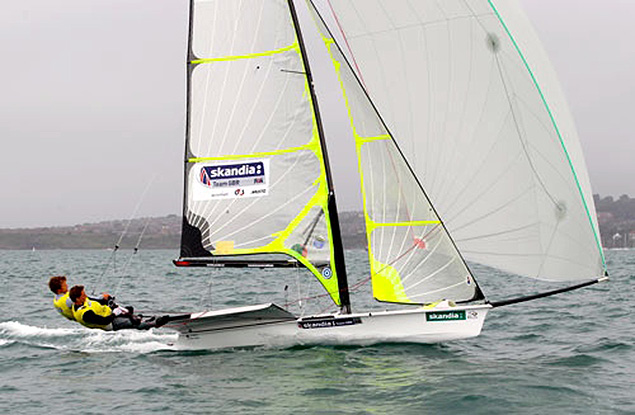 The 49er ideal – perfect balance, minimal spray, maximum speed
The 49er ideal – perfect balance, minimal spray, maximum speed
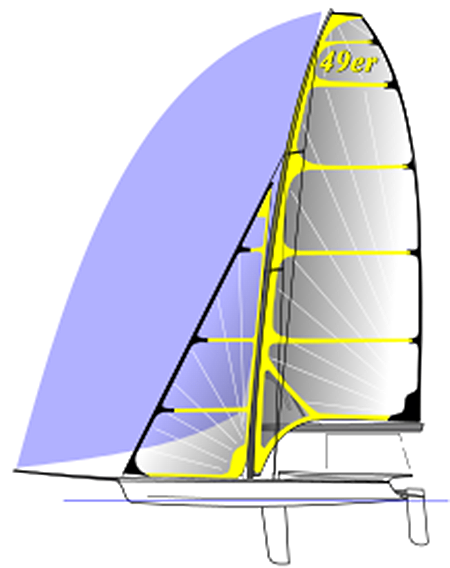 The 49er still looks more modern than the day after tomorrow
The 49er still looks more modern than the day after tomorrow
In thinking that, you’d be absolutely right. When everything is in the right place and functioning smoothly, the 49er is an impressive sailing machine. But when she goes head over heels or whatever you want to call it (the word “capsize” is much too tame), everything seems to get fouled up with everything else, and unravelling it all can take for ever.
There’s one particular trick of the 49er which sums up the challenge of sailing these very special Olympic boats. The hulls are just slips of things, with only the minimum of buoyancy needed to get them up to speed, and then as the speed confers extra buoyancy, you’re in business. But in that crucial moment as you break out the assymetric in a proper breeze before working speed develops, you might just see the bow dipping a little, then the nose goes that tiny bit under water, and things go from bad to worse in an instant. You’re going down the mine. And a very deep mine it can be too.
So you might wonder why the 49er is ringing a bell in Ireland at the moment. It’s clearly a specialist interest, and there’s no denying that those who can make a good fist of sailing it are an elite. Furthermore, it really only makes real sense when seen as an Olympic class, which makes it about as different as possible from the trusty old Laser at the bottom of the garden, the only boat to succeed in being an Olympic class while continuing to be universally popular with a huge variety of users at the same time.
Thus the 49er and its adherents are in a sort of parallel universe which only actively intersects in three ways with the rest of us. The main one is when the buildup to the Olympics and the Olympics themselves are topping the headlines, and the other two are when there’s a major global championship involving the 49er, possibly at a nearby venue, while the third is when the special group of 49er trainees under the ISA Performance Scheme are in Ireland on one off their fortnight-long training camps, as is happening at the moment at the National Yacht Club in Dun Laoghaire.
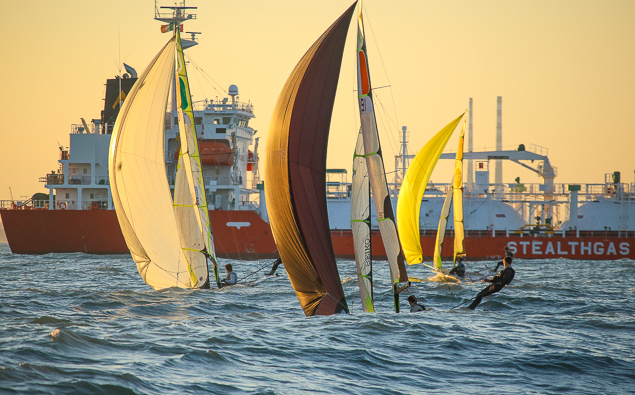 Ireland’s core 49er Training Squad in action in Dublin Bay this week – in foreground are Sean and Tadgh Donnelly, beyond are Robert Dickson and Sean Waddilove, and Oisin O’Driscoll and Mark Hassett. Photo: Afloat.ie
Ireland’s core 49er Training Squad in action in Dublin Bay this week – in foreground are Sean and Tadgh Donnelly, beyond are Robert Dickson and Sean Waddilove, and Oisin O’Driscoll and Mark Hassett. Photo: Afloat.ie
 A word with the coach – Schull’s Oisin O’Driscoll and Mark Hassett with Tytus Konarzewski. Photo: Afloat.ie
A word with the coach – Schull’s Oisin O’Driscoll and Mark Hassett with Tytus Konarzewski. Photo: Afloat.ie
It’s unusual, as many of the training camps have tended in recent years to be based during our winter at Cadiz in southern Spain. But don’t go along to the National YC this weekend expecting to see an array of 49ers. For a start, training sessions are a rather private affair. But as it is, we’re talking specialist numbers in dedicated highly-trained small groups, and to best understand that, a quick canter through the history of the 49er helps.
The modern skiff emerged from the legendary Sydney Harbour 18 footers which raced for impressive money prizes on that wonderful stretch of city-surrounded water, the racing closely followed by big harbour ferries crowded out with spectators betting like crazy on the results. In the early days, the quest for speed was met by crowding on ever more sail and somehow fitting aboard ever more crewmen to hang out as best they could – sometimes on each others shoulders – to keep the whole show on the road. And if they happened to capsize in a harbour whose waters might include a man-eating shark or two, not to worry – by this stage the sail areas had become so enormous it was reckoned the vast spread of white cloth on the surface of the sea would frighten away even the hungriest shark.
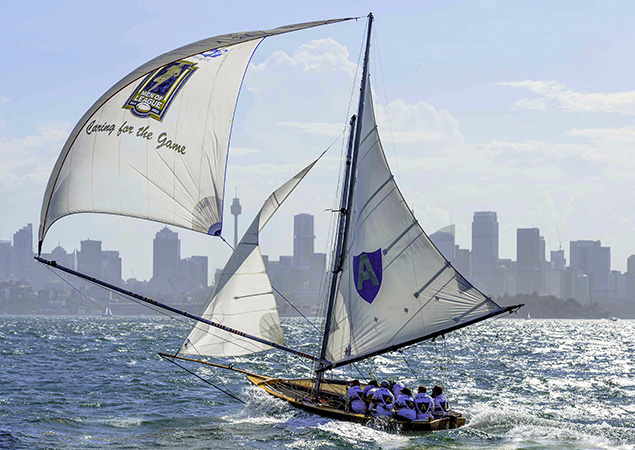 When power and weight mattered – a well-crewed Sydney Harbour 18-footer in all her glory. As designers learned that less is more, the leaner skiff concept emerged.
When power and weight mattered – a well-crewed Sydney Harbour 18-footer in all her glory. As designers learned that less is more, the leaner skiff concept emerged.
The rest of the world had just become used to these mad Sydney sailors using colossal sail area and moveable human ballast to achieve speed when the Aussies with innovative geniuses like Frank Bethwaite started to go the other way. The boats were still 18ft long. But with trampoline-like wings either side and a smaller crew hung out on trapezes, better speeds could be obtained with much less fuss. The Sydney Harbour 18ft skiff was re-defined, and with the 2000 Olympics scheduled for Sydney, the idea that a modern purpose-developed skiff would make an ideal Olympic sailing boat gained traction.
Or at least that’s how it all looks in hindsight. Doubtless there are as many narrative versions of how it all really came about as there were skiff types which showed up for an official Olympic Skiff selection trial on Lake Garda in 1996. What we do know is that the 49er skiff, designed by Julian Bethwaite of Australia and built by Dave Ovington in the northeast of England, emerged head and shoulders above everything else. And unlike a much earlier time when selection trials for a three man Olympic keelboat somehow saw the Soling being selected despite the fact that the Etchells 22 was clearly the better boat, this time righteousness prevailed, and the 49er made her Olympic debut just four years later.
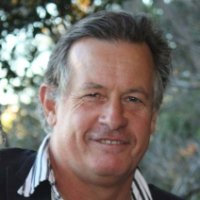 Julian Bethwaite, designer of the 49er
Julian Bethwaite, designer of the 49er
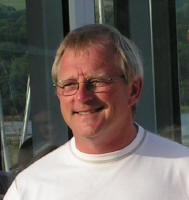
That in itself was something of a miracle of productivity, as the 49er has settled down with just two main builders worldwide, Ovington in England and MacKay in New Zealand.
That things were a bit hectic with larger-than-life characters in the early days goes without saying, and Irish sailing kept intersecting with it in a tangential way. Thus Gerry Donleavy of Dun Laoghaire, whose notable sailing CV incudes the British & Irish Flying Fifteen titles, found himself in 1990 at the FF Worlds in Brisbane, Australia, and among the boats he was racing against was one crewed by Dave Ovington from Newcastle in the northeast of England. Dave was a noted builder of Flying Fifteens (for which Gerry was Irish agent) and other racing machines, with Ovington’s career given an early rocket-assisted start when he built an all-conquering Enterprise dinghy for a rising talent called Lawrie Smith.
There was a layday during those 1990 Brisbane FF Worlds, and the competitors were taken off on a river cruise which included watching the local skiffs racing. Ovington was completely hooked by the whole skiff concept. He soon linked up with the formidable brains of the Bethwaite family to work towards production, but as Julian Bethwaite – son of the legendary Frank - is a perfectionist and endless experimenter all in one, it reputedly took at least five years of trialling and testing before he was satisfied with what eventually became the aft end of the new 49er.
Nevertheless the new machine was ready enough for Lake Garda in 1996, and the rest is history. But so too alas is Dave Ovington. The production rate for his surprisingly small “factory” in North Shields on Tyneside close east of Newcastle was already prodigious, with a selection of superb racing craft, yet he and the other builders managed to meet most of the demand for 49ers for the 2000 Olympics, and things were in running order for the 2004 Games as well.
But the pace was literally killing. In 2005, while getting ready to go out for a family sail on Lake Windermere, Dave Ovington dropped dead with a heart attack. He was only fifty. His sudden departure brought home a realisation of all that he had done in creating a world focus of top quality racing boat building in the unlikely setting of Tyneside, using dedicated local labour – only around fifteen in all - which he trained to be among the most talented boat-makers in the world, despite the fact that many of them don’t sail.
Dave Ovington left quite a legacy, and the continuing success of Ovington Boats is tangible evidence of it, with the company run by a dedicated triumvirate of three executives. Gerry Donleavy says he never fails to be impressed by the good working atmosphere in a plant producing top-level boats on which an entire nation’s Olympic hopes will rest, and it’s the reassuring structure on which the 49er Class is based which has led to the ISA Performance Director James O’Callaghan making such a strong commitment to the class.
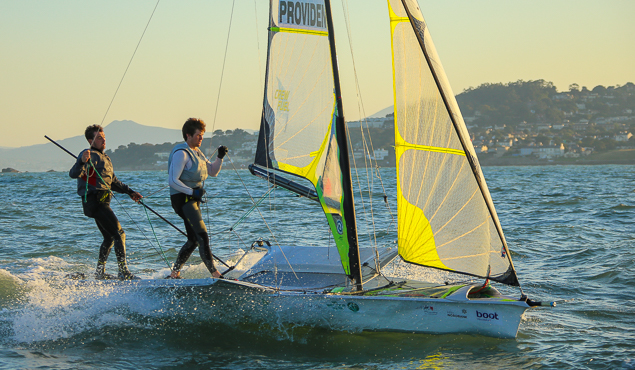 A long way from Schull. Mark Hassett and Oisin O’Driscoll in this week’s Dublin Bay 49er Training Camp. Photo: Afloat.ie
A long way from Schull. Mark Hassett and Oisin O’Driscoll in this week’s Dublin Bay 49er Training Camp. Photo: Afloat.ie
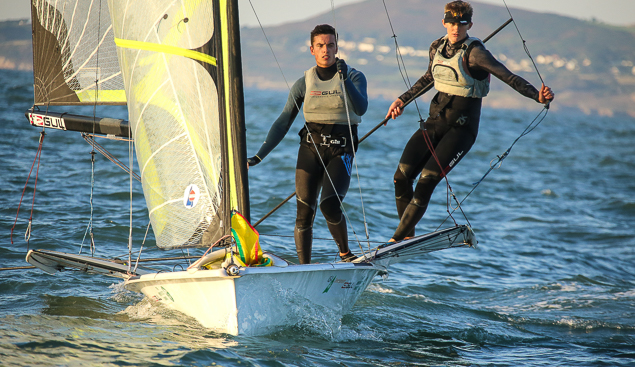 Sean Waddilove and Rob Dickson make up one of the ISA’s three core 49er crews. Photo: Afloat.ie
Sean Waddilove and Rob Dickson make up one of the ISA’s three core 49er crews. Photo: Afloat.ie
“We have to operate on a tight budget” says O’Callaghan, “and the 49er offers great value. It’s absolutely standardised, you just buy the boats and the parts and the sails off the shelf, and you know it’s a level playing field after that. With some other non-single-handed Olympic classes, there’s too much choice, too many builders involved. But with the 49er, the unknowns are taken out of the equation, and you can get on with planning and implementing a training programme relatively untroubled by boat issues”
In keeping it that way, the 49er Class worldwide has benefitted from Irish experience in running sailing organisations. Marcus Spillane (42) hails from Cork and a Crosshaven sailing background, but this past week he has been putting the final details into place in his new base in San Francisco after several gloriously busy years at the top end of some very exciting business ventures in New York. It’s said of running your own business that if you’re not having fun or making a lot of money, then why are you doing it? But Marcus Spillane seems to manage to do both, and he fits in quite a bit of sailing while he’s at it, having got involved with the Laser 2s in UCC both as sailor and then longer term as an administrator, through which he met Laser 2 designer Frank Bethwaite (who unlike Dave Ovington, lived to a lively 92) and his son Julian.
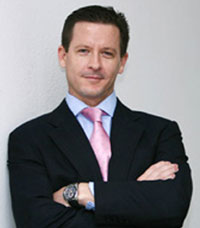 Marcus Spillane, President of the International 49er Class, has this week been confirmed as President of the International NACRA 17 Class.Spillane’s other sailing has included Fastnets and Round Irelands and a lot of Etchells 22s and other racing in America (he’ll be doing the Caribbean 600 next February in a Swan 66), but as well he somehow found the time to include the 49er, and has great memories of fun championships with the congenial ISA coach Rory Fitzpatrick as crew.
Marcus Spillane, President of the International 49er Class, has this week been confirmed as President of the International NACRA 17 Class.Spillane’s other sailing has included Fastnets and Round Irelands and a lot of Etchells 22s and other racing in America (he’ll be doing the Caribbean 600 next February in a Swan 66), but as well he somehow found the time to include the 49er, and has great memories of fun championships with the congenial ISA coach Rory Fitzpatrick as crew.
Yet even a couple of minutes of talking with Marcus Spillane will reveal that he has more useful ideas about how sailing generally and its specialist sectors can be properly run than a whole committee room full of blazers. So naturally he was soon drafted into the admin side of the 49er on a voluntary basis, he then became the class’s World CEO in addition to his multiple other activities in business and sport, and in 2012 he was elected President of the International 49er Association with colleague Ben Remocker of Canada as Class Manager.
By this time the 49ers had gone through a re-vamp to improve the value and boat appeal which James O’Callaghan – who had been appointed ISA Performance Director in 2006 – rates so highly. While the basic concept remained the same, it was agreed that there had been so many advances in sails, spars and rigs in sailing generally that in order to reinforce the 49er’s image as being cutting edge, the rig should be up-graded and the one design nature of the hull should be put beyond all question.
This was done in 2009, resulting in the 49er we see today, based on a hull from master-moulds made only by MacKay, but producing boats in the Northern Hemisphere with Ovington, and in the Southern with MacKay, under a production programme so tightly controlled that you could argue the modern 49er is the world’s first true one design.
Of course it’s still a minority interest as a boat to sail, even if what happens in the class afloat and in the training camps is increasingly a matter of pubic interest. At a major championship in North America they might expect to see 80 boats, if it’s a major international championship held in Europe (where the class’s ancestral home of Lake Garda is a popular venue) you can expect 120 boats.
Yet so much is at stake among those 120 boats in international terms that the efficient running of the class worldwide is vitally important, and for the past four years the Spillane/Remocker duo have been making such a good job of running the International 49er Association that as of Wednesday night this week they have also taken on the running of the new Olympic class, the 2011-designed NACRA 17 Catamaran, which with its mixed-gender two person crew made a successful debut at Rio, but found itself with a class administration no longer able to cope with demand.
That the NACRA 17’s future was placed in Marcus Spillane’s hands will tell you something of how highly the 49er Class Association president from Ireland is rated in the administration of international sailing, and he also finds time to represent Ireland at the top – he’ll be very effectively working the rooms on behalf of many interests at the World Sailing conference next month in Barcelona.
He does all this with such good humour and enthusiasm that it made learning more about the 49er a very entertaining chat rather than an earnest journalistic endeavour, so now we have some idea about what those guys are sailing as they buzz about Dublin Bay this weekend.
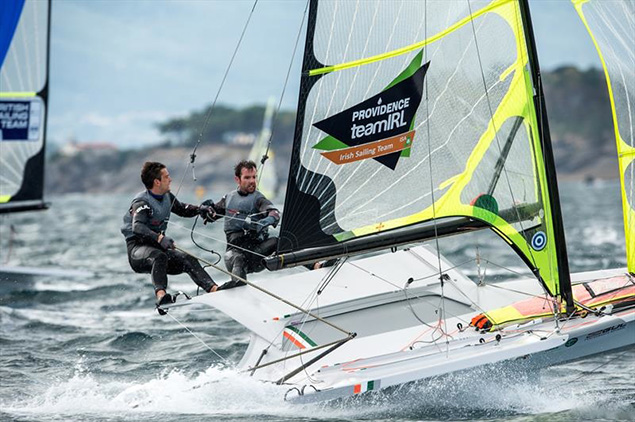 Ryan Seaton and Matt McGovern in action. Following the 2016 Olympics, they will now provide the 49er Class with two crews, as McGovern has teamed up with a new sailing partner, and Seaton is currently testing three different potential crewmates.
Ryan Seaton and Matt McGovern in action. Following the 2016 Olympics, they will now provide the 49er Class with two crews, as McGovern has teamed up with a new sailing partner, and Seaton is currently testing three different potential crewmates.
For some years now, the 49er in Ireland was all about Ryan Seaton and Matt McGovern from Belfast Lough, whose often lone pursuit of training competition and international championships was quietly heroic in itself, for with a different spin of the dice they might have been on the podium in 2012. Then they hit world headlines in 2016 by winning gold in Palma in April, and in Rio in August they had two race wins and were definitely contenders.
Also very much in the public eye were Andrea Brewster and Saskia Tidey of the RIYC in Dun Laoghaire, who made it into an Olympic 49er FX place at the last chance in February 2016, and then had the energies of top coach Tytus Konarzewski given over to them virtually full time in the buildup to Rio. The result was a more-than-respectable performance, and in all the intense Irish involvement in Olympic 49er campaigning was well justified.
This fitted very neatly with The Plan. It’s given all sorts of official titles, and reams of reports could be written about it, but basically since about 2014 James O’Callaghan has had three very promising young 49er crews in training, and they came on so well that by the end of 2014 they’d got to a stage he hadn’t expected to reach until early 2016, such that this week – albeit in a low key way – he is introducing a complete squad which will raise 49er sailing in Ireland, and for Ireland, to a new level.
This is in the knowledge that Matt McGovern has parted the ways with Ryan Seaton to set up a new 49er equipe with another crewmate, while Seaton is keen to stay in the game and he has three potential new partners in mind, though whether he’ll be testing any of them in the current programme in Dun Laoghaire remains to be seen.
Then there are the Nippers, Doug Elmes of Kilkenny and Colin O’Sullivan of Malahaide, the competent kids who took bronze in the 420 Youth Worlds in Malaysia at New Year, won the 420 Irish Opens during the summer going away, and then at the end of August suddenly appeared at their sailing base of Howth with their newly-acquired 49er, having leapt clean over any ideas of a 29ers or a 470 on the way.
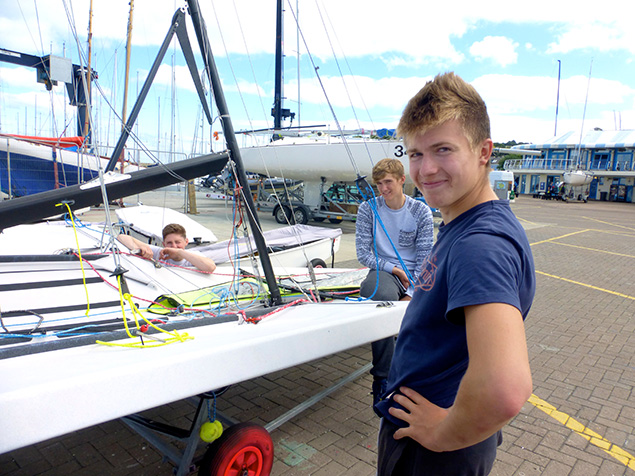
As for the 29ers, breeding ground for future 49er champs, the two Harrys – Durcan and Whittaker of Royal Cork – may be Ireland’s only active representatives, but they made a great job of it by winning the British Championship 2016, and now their sights are set on the 29er Worlds next year in California, but after that a 49er is surely the logical step.
Of course we’ve had waves of 49er interest in Ireland before – when it was new around 2000-2002, the class surged to maybe seven boats. What we’re looking at now is a comparable number, but there a depth to it that’s encouraging, and the three favoured young crews have been performing beyond expectation to provide a core for potential success well into the Olympic future.
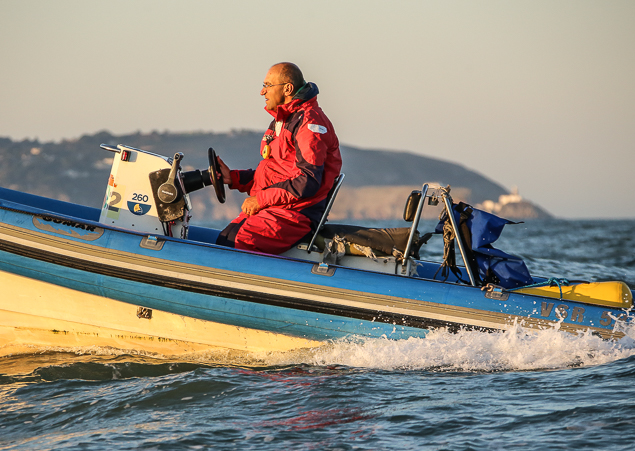 The Main Man. Tytus Konarzewski is one of Europe’s most respected sailing coaches, and the Irish 49er training squad have the use of his services until the end of 2016. Photo: Afloat.ie
The Main Man. Tytus Konarzewski is one of Europe’s most respected sailing coaches, and the Irish 49er training squad have the use of his services until the end of 2016. Photo: Afloat.ie
Thanks to the ISA’s Development and Youth Academies and Performance Pathways, and the quiet behind-the-scenes work by the Irish Sailing Foundation to add resources to funds coming from Sports Ireland, the work can go on. And although Tytus Konarzewski’s special talents were almost wholly devoted to coaching Andrea Brewster and Saskia Tidey in the six-month buildup to the Olympics, his contract runs to the end of 2016, and he’s now fulltime with the 49er crews, and there’ll be two more two-week training camps before the end of the year, both in Cadiz with one in November and the other in December.
 Making the best of light breezes and lumpy seas in Dublin Bay. Rob Dickson and Sean Waddilove, with the Donnelly brothers beyond. Photo: Afloat.ie
Making the best of light breezes and lumpy seas in Dublin Bay. Rob Dickson and Sean Waddilove, with the Donnelly brothers beyond. Photo: Afloat.ie
The three crews marked for destiny are Oisin O’Driscoll from Schull and Mark Hassett from Baltimore, Sean and Tadgh Donnelly from Dun Laoghaire, and Robert Dickson from Howth with Sean Waddilove from Skerries. In this year of all years, Irish sailors have some idea of just how much is involved in a campaign towards the Olympics. We wish them well, these young people and their supports teams.
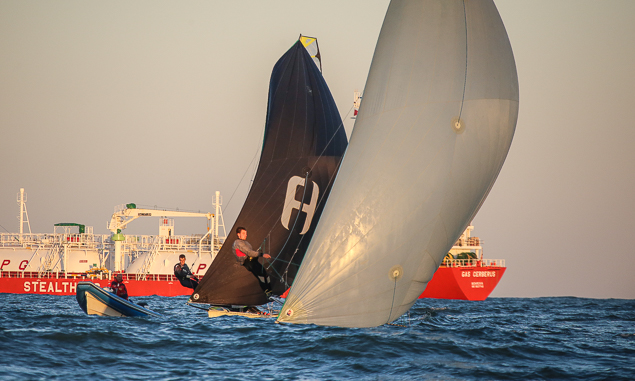 They say the truest good work is done by stealth, but we never thought to see it as clearcut as this…….The 49ers head into the sunset after making the most of an October evening. Their current training camp on Dublin Bay continues to the end of next week, and then training is resumed with another two week camp in Cadiz in November. Photo: Afloat.ie
They say the truest good work is done by stealth, but we never thought to see it as clearcut as this…….The 49ers head into the sunset after making the most of an October evening. Their current training camp on Dublin Bay continues to the end of next week, and then training is resumed with another two week camp in Cadiz in November. Photo: Afloat.ie




























